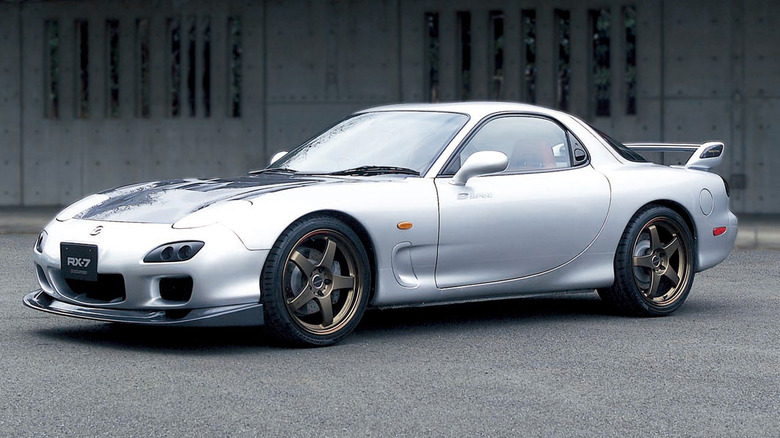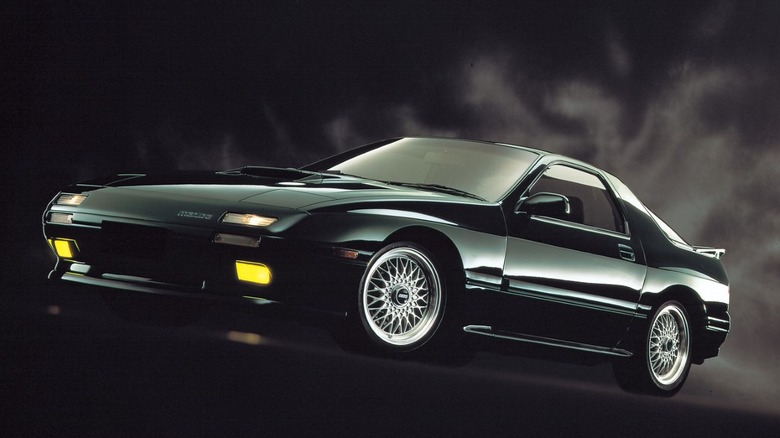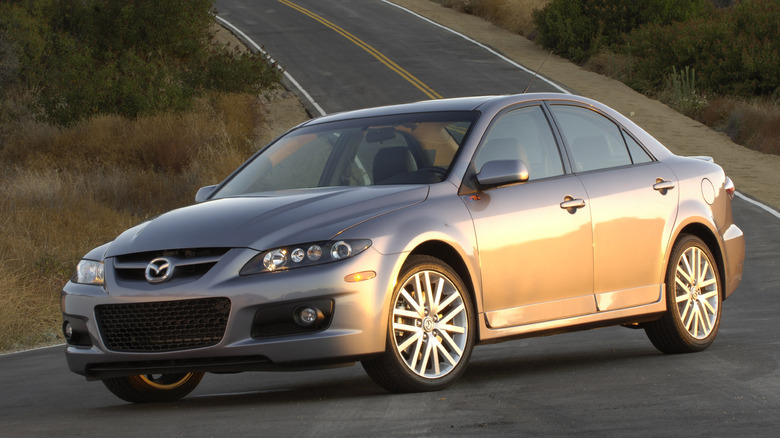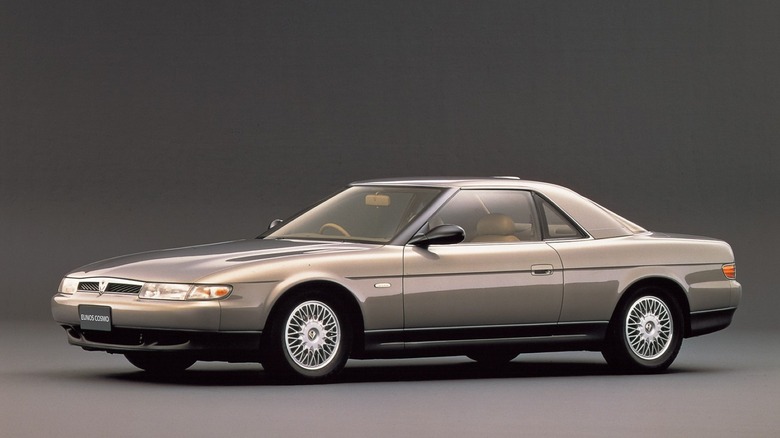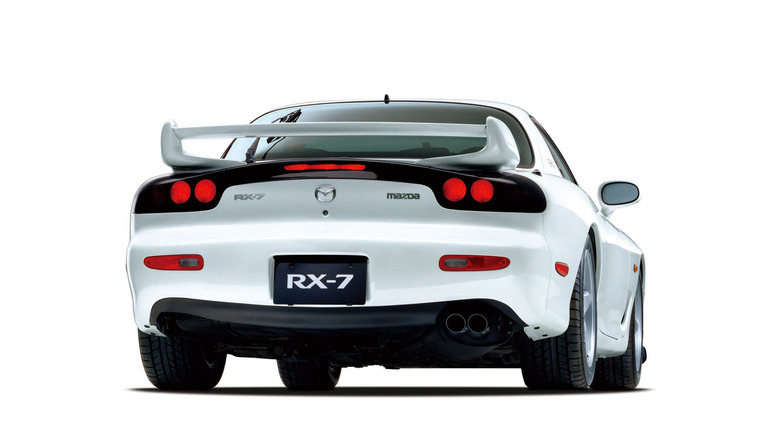11 Of The Fastest Mazda Cars Ever Made, Ranked By Top Speed
Mazda isn't exactly a brand that springs to mind when talking about speed. However, the Japanese have made some amazing sports cars throughout their history, with a few gaining legendary status. The most fascinating part is that the company has never followed the norm. Mazda's persistent use of the rotary engine is perhaps the perfect example, as it shows its dedication to making unique vehicles. Still, as you'll find out in this tale about Mazda's fastest cars, the company wasn't shy about producing innovative piston engines as well.
Were they fast, though? You bet they were! Sure, Mazda never intended to compete with the likes of Ferrari and Lamborghini, but its sports cars were faster than you would ever need them to be. Some of its fastest vehicles were also designed to be luxurious, rather than sporty, but you know Mazda — it has always injected some sportiness into its machines. In this article, we will look closely at the fastest Mazda cars ranked by top speed, from sleek sedans to legendary sports cars. So, strap in, because it's Mazda-per-hour time!
1996-2000 Mazda Millenia/Xedos 9 Miller Cycle (143 mph)
You don't need to look deep into Mazda's history to see how innovative the company has been when it comes to engines. Back in the 1990s, the company sold luxury sedans designed to compete with Lexus and Acura under the Millenia/Xedos moniker. To differentiate itself — like it always does — Mazda opted for small V6 engines for these cars. It was so tiny, in fact, that the entry-level engine was a 2.0-liter V6 unit. A 2.5-liter upgrade was also available.
However, here we'll be talking about the 2.3-liter supercharged V6 that works on the Miller cycle. Come again? It's an alternative four-stroke combustion in internal combustion engines, wherein the intake valve is closed later to increase thermal efficiency. This would make the engine less powerful because less air/fuel mixture would be compressed inside the chamber, which is not really in line with today's "Mazda-per-hour" theme. However, Mazda's trick was the use of a supercharger, which maintained compression inside the chamber, even when the valve was open.
As a result, the small 2.3-liter V6 unit produced 211 hp at a relatively low 5,300 rpm, along with a solid 214 lb-ft of torque. It didn't make the Millenia/Xedos 9 very quick off the line, with the sedan arriving at the 62 mph mark in 9.5 seconds. However, probably thanks to the long-legged four-speed automatic, the Millenia/Xedos 9 had a top speed of 143 mph. Still, if you are thinking about buying one, keep in mind that this is a front-wheel-drive luxury sedan designed to eat miles in the most serene way possible.
2003-2008 Mazda RX-8 (146 mph)
The RX-8 is the odd child in Mazda's lineage of rotary-powered sports cars. Not only did it return to the engine's naturally aspirated roots and was down on power from the RX-7, but it was also a quasi-four-door car. Not to mention that Mazda didn't really solve its rotary reliability issues with the brand-new Renesis engine, despite deleting forced induction.
Despite all of these issues, though, we think the RX-8 is an underrated JDM car that deserves more attention. To begin with, it's more usable than any rotary Mazda before. Its interior offers genuine space for four passengers, with the rear half-doors helping ingress and egress. Moreover, RX-8's cabin had quite a lot of storage area, with a useful 7.6 cubic-feet of trunk space. If that wasn't enough, you could always use the rear seats to put additional bags.
With all that said, the real reason why the RX-8 deserves its place in the JDM pantheon of greats is the excellent driving experience. For instance, its 1.3-liter two-rotor engine had a 9,000 rpm redline. The shifter was also precise and mechanical. Oh, and the handling balance was perfect. You could argue that with 231 hp on tap, the rotary was slightly underpowered, but 0 to 60 mph in six seconds is still considered fast today. How many four-door sports cars that weighs 3,000 pounds can match that? Besides, RX-8's top speed of 146 mph will make you faster than most cars on the road today.
2018-2021 Mazda6 Skyactiv-G 2.5 Turbo (149 mph)
As of 2024, the Mazda6 is no longer on sale in North America. That's quite unfortunate, because it was one of the best mid-size sedans available, with handsome styling that still looks better than its more modern rivals. With the 2.5-liter turbo engine, the last Mazda6 was also very potent and eager, producing a healthy 250 hp and 320 lb-ft of torque on premium fuel.
As a result, the front-wheel-drive sedan arrived at the 60 mph mark in just 6.1 seconds on its way to a top speed of 149 mph. Crucially, it was more engaging to drive than its rivals, with tight handling and precise steering. Despite that, Mazda was able to minimize road imperfections entering the cabin, and was quiet on the highway, too. You could say it provided sportiness and refinement in equal measures. Furthermore, the interior stood the taste of time. Sure, it's not as high-tech as its modern alternatives, but the ergonomic layout, excellent material quality, and minimalistic design give it a timeless, premium vibe.
Yet despite its potent engine and engaging handling, the last turbocharged Mazda6 wasn't a performance sedan. Sure, it was quick, but by 2021 a proper performance sedan could hit 60 mph in less than 4 seconds. The Mazda6 was a warm, rather than a hot sedan. Not that there is anything wrong with that — in fact, we wish the Mazda6 could return as a warm performance sedan on CX90's RWD platform, powered by the 3.3-liter turbocharged inline-six.
1989-1991 Mazda RX-7 FC (149 mph)
From its uncommon rotary powertrain to its history of motorsport success, the Mazda RX-7 is one of the most iconic cars in HDM history. That's true for all three generations, even the overlooked second-gen FC model. It might not be as popular as the FD generation, but the RX-7 FC has all the ingredients of a thoroughbred sports car. Classic proportions. Rear-wheel drive. Lightweight. Powerful. Add a driver to the mix, and fun ensues.
The RX-7 FC does things differently to modern sports cars. With 202 hp on tap, the most powerful turbocharged 1.3-liter twin-rotor engine pales in comparison to what's available today. However, it only needed to move 2,899 pounds, resulting in a quick 0 to 62 mph time of 6.7 seconds. The 149 mph top speed is also pretty good for the era — the BMW M3 E30, for instance, could only muster 146 mph. You could also rev the turbocharged rotary to 8,000 rpm and enjoy a slick-shifting five-speed manual transmission!
Look, there is no denying that the Wankel rotary engine is a reliability nightmare. However, if you know how to take care of RX-7 FC's engine, it can be durable. With good quality oil, you'll extract many more miles from it. To spice things up, the RX-7 FC is still affordable for a sports car that provides a fun and unique driving experience.
2006-2008 Mazda Mazdaspeed 6 (149 mph)
To confirm that the recently discontinued 2021 Mazda 6 Turbo was only a warm sedan, we need to rewind the tape for 15 years. Then, Mazda launched the Mazdaspeed 6 — a performance sedan based on the regular 6, cranked up to 11. To begin with, Mazda opted for a 2.3-liter turbocharged inline-four engine producing an excellent 274 hp and 280 lb-ft of torque. Then, it equipped the Mazdaspeed 6 with AWD to increase traction, yet kept the weight at a reasonable 3,500 pounds. As a result, this sleek mid-size sedan could reach 60 mph in 6.2 seconds and then keep going all the way to 149 mph.
However, the Mazdaspeed 6 wasn't a one-trick pony. In fact, it was never designed for outright speed, but for attacking corners swiftly and precisely. Notably, its computer-controlled Active Torque Split All-Wheel Drive system monitored wheelspin, yaw, and steering angle, and could send up to 50% of the torque to the rear wheels. Moreover, it had a limited-slip differential on the front axle, accompanied by an electric clutch at the rear, all working in unison to provide exceptional handling balance.
For additional crispness, Mazda strengthened the 6's chassis, making it 50% more rigid. Adding to the Mazdaspeed's appeal as a driver's car was the slick-shifting six-speed manual gearbox. Let's also not forget that the Mazdaspeed 6 was a mid-size sedan that offers useful space for passengers and cargo.
2007-2009 Mazda Mazdaspeed 3 (155 mph)
Up until now, we showed you reasonably powerful Mazda cars, at least respective to their classes. Back in 2006, though, the Japanese company was fighting the horsepower war with the first-gen Mazdaspeed 3. This front-wheel-drive hot-hatch packed the same 2.3-liter turbocharged engine from the Mazdaspeed 6, here producing 261 hp and 280 lb-ft of torque. To provide some context, the front-wheel-drive Golf 5 GTI produced 197 hp, and even the all-wheel-drive Golf 5 R only had 247 hp to play with.
Because the Mazdaspeed 3 retained the front-wheel-drive layout of the standard 3, it also weighed just 3,153 pounds, resulting in a 0 to 60 mph sprint of just 5.9 seconds. Mazda also improved the aerodynamics by dropping the ride height by 0.4 inches and implementing an underfloor cover. This was enough to bring the Mazdaspeed 3 to the electronically governed 155 mph, an impressive figure for a hot hatch even today.
However, having such a powerful engine driving only the front wheels is often a recipe for disaster. Fortunately, Mazda did its part and equipped every Mazdaspeed 3 with a limited-slip differential, and restricted the engine's torque in the first three gears. These limitations were offset with a more rigid shell than the standard hatchback, leading to much better handling. The multi-link suspension, retained from the standard 3, aided by stiffer springs, also helped matters, while big 12.6-inch front brakes made sure you'll stop on time.
2010-2013 Mazda Mazdaspeed 3 (155 mph)
Mazda kept the same front-wheel drive, big turbo power recipe for the second-gen Mazdaspeed 3. The engine remained unchanged, gaining just two hp, but the engine's 263 hp was available at a relatively low 5,500 rpm. Moreover, the second-gen Mazdaspeed 3 was heavier than before, weighing 3,272 pounds, so the 0 to 60 mph time was now 6 seconds. The electronically-limited top speed of 155 mph remained the same.
Speed wasn't ever the issue with the Mazdaspeed 3, though. It was the front-wheel-drive configuration. Sure, Mazda has put a limited-slip differential to limit wheel spin during hard cornering, but the Mazdaspeed 3 was never going to beat an all-wheel-drive hot hatch. In the second-gen model, that was exaggerated quite significantly, because it had to compete with the second-gen Focus RS.
Ford's hot-hatch was also front-wheel drive and had a potent turbocharged engine. However, that's where the similarities end. The Focus RS also had Ford's Revoknuckle front struts, which all but eliminated torque steer. It also had 305 hp and a top speed of 163 mph. Its 2.5-liter turbocharged five-cylinder sounded more interesting, too.
The aftermath? The Focus RS became a front-wheel-drive legend, and one of the best cars ever built with an inline-five engine. Meanwhile, the second-gen Mazdaspeed 3 faded to obscurity. Maybe Mazda should have made a more amplified effort, particularly because the regular Mazda3 was already an excellent car to drive. Unsurprisingly, the Mazdaspeed moniker was discontinued after the second-gen Mazdaspeed 3.
1990-1996 Mazda Eunos Cosmo (155 mph)
You could argue that the RX-7 FD is the best car Mazda has ever made — but that's only until you learn about the Eunos Cosmo. A high-tech, RWD grand-tourer, the Cosmo was designed to compete in the highest echelon of the industry, including the likes of Jaguar and Bentley. Mazda even planned to launch it in the U.S. under its premium brand, Amati, but as you probably know, that never came to fruition. Instead, it remained a JDM-only model, sold under the premium brand Eunos, the Japanese equivalent of Amati.
The Cosmo had everything it needed to compete with the big dogs, though. It had a sleek design that looked oh-so-anime and an even sleeker, minimalistic interior with a fantastic wraparound dashboard. Don't get that confused with low-tech, as the Cosmo was the world's first car with a color touchscreen with GPS functionality. It even had an on-board TV. The futuristic vibe was further enhanced by the second instrument panel for the passenger.
Cosmo's mechanical bits were even more impressive. In the rear, the Cosmo had a multi-link suspension with quad dampers. Furthermore, under the hood, there was a 2.0-liter triple-rotor engine producing 280 hp and 297 lb-ft of torque. The Eunos Cosmo was only available with a four-speed automatic, but Mazda thought of it as a luxury car, so it was fit for purpose. Besides, with a 0 to 60 mph time of 5.8 seconds and a 155 mph top speed, it was more than fast enough for its time.
1992-2002 Mazda RX-7 FD (158 mph)
The Cosmo might have been the most advanced car Mazda ever built, but the RX-7 FD is undoubtedly the most famous. This twin-turbo, twin-rotary sports car is very unique and provides thrills you won't find in any other vehicle. It looks timeless, too, with elegant lines, nicely integrated pop-up headlights, and perfect proportions that are a magnet for your eyes even today.
It gets even better once you start that engine. The 1.3-liter twin-rotor Wankel is the most advanced ever put in a Mazda car, featuring two turbochargers for additional oomph at lower rpm. Even so, it revs freely, with the max 255 hp arriving at 6,500 rpm, and the max 217 lb-ft of torque arriving at 5,000 rpm. Mazda offered two transmissions — a five-speed manual and a four-speed automatic, but you know where your money should go. The stick shift is not only more engaging, but it's super precise and offers wonderful mechanical feel.
Then there is the weight, or lack of it, to be more accurate. The RX-7 FD weighs just 2,789 pounds, which in today's weight currency is featherlight. Crucially, it's distributed equally on both axles, providing balanced and nimble handling. Add to that a low-sitting rotary engine to the mix, and you have the formula for a true driver's car. The svelte nature of the RX-7 FD helped in the performance department, too, with the RWD coupe sprinting to 60 mph in 4.9 seconds and reaching 158 mph with the speed governor removed.
2002 Mazda RX-7 FD Spirit R Type A (159 mph)
The base RX-7 FD was already an impressive sports car, but Mazda wasn't done perfecting its flagship performance model. So, in 2002, it launched the Spirit R Type A — an amped-up version with 276 hp and has an 8,000 rpm redline, all while weighing 88 pounds lighter. This was the most extreme version of the RX-7, with the rear two seats removed and the front ones being replaced by Recaro buckets.
Forged 17-inch BBS wheels were part of the package, too, accompanied by special Bilstein shocks. For greater stopping power, Mazda upgraded the brakes with drilled rotors and rigid stainless steel mesh brake hoses. Meanwhile, at the rear, the Spirit R Type A has an adjustable carbon fiber wing. As a result, the 0 to 60 mph sprint was cut to 4.8 seconds, and the top speed (without governor) was around 159 mph.
The Spirit R model was also available as a four-seater with manual transmission (Type B), and a four-seater with a four-speed automatic (Type C). Obviously, the Type A model is the most sought-after today, but any RX-7 FD is an interesting project car. Just make sure to learn these things about the rotary engine before buying an RX-7.
2002 Mazda RX-7 FD Bathurst Type R (160 mph)
Alongside the Spirit R range, Mazda also introduced the Bathurst Type R in 2002. This special edition commemorates the Bathurst 12-hour race in Australia, where Mazda won three times (1992 to 1994) with the RX-7. The Bathurst Type R got the upgraded, 272 hp twin-turbo, twin-rotary engine, and most of the enhancements of the Spirit R. However, this was a slightly more advanced model, as it featured a height-adjustable Showa suspension.
You couldn't adjust the suspension from behind the wheel, though — that could only be done at a Mazda dealer. If you chose the lowest setting, the Bathurst R was capable of hitting 160 mph according to some publications, perhaps because of the lower drag. The thinner tires compared to other versions of the RX-7 FD (225-section rear), certainly helped matters even further. Due to the lower unsprung weight, they might have also aided with acceleration, with the Bathurst Type R capable of hitting 60 mph in 4.7 seconds.
Compared to the Spirit R, the Bathurst Type R had more sedate-looking five-spoke alloys. However, it was also equipped with special carbon tone panels on the dashboard, a carbon shift knob, and a carbon parking brake lever. The idea was to add a race-car vibe to the cabin. However, the Bathurst Type R lacked the Recaro buckets of the Spirit R, so we are not entirely sure about that.
How Did We Rate These Vehicles?
For this article, we rated Mazda's cars by overall top speed. Although this metric is not as popular as 0-60 times, it does give a chance to older models, which, either due to old transmission tech or driving only two wheels, are slower to 60 mph. So, this gave a chance to cheap exotics like the Xedos 9 Miller Cycle to appear.
As for the data, for most models, we used the official Mazda figures. However, in the case of the special-edition RX7 models, we scoured the internet to find how fast they went in real-world conditions, because Mazda didn't provide top speed figures. The idea, as always, was to provide you with accurate information.
